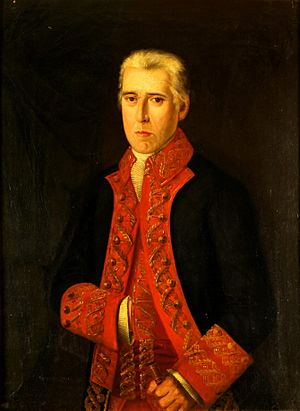Antonio de Escaño facts for kids
Quick facts for kids
Antonio de Escaño
|
|
|---|---|

Portrait at the Museo Naval de Madrid
|
|
| Birth name | Antonio de Escaño y García de Cáceres |
| Born | 1750 Cartagena, Spain, |
| Died | 12 July 1814 Cadiz, Spain |
| Allegiance | |
| Service/ |
|
| Years of service | 1767–1810 |
| Rank | Lieutenant general of the Navy |
| Unit | Second in command of Spanish fleet:
|
| Commands held | Commanding Officer of ships of the line:
|
| Battles/wars | American Revolutionary War
Spanish-Barbary Wars |
Antonio de Escaño y García de Cáceres (born in Cartagena, Spain in 1750, died in Cádiz on July 12, 1814) was an important Spanish naval officer and government leader. He fought in many major sea battles, including the famous Battle of Trafalgar. He also served as Spain's Minister of the Navy. Many people consider him one of the best naval thinkers of his time. He was very smart and studied things like shipbuilding, chemistry, and history.
Contents
Antonio de Escaño started his naval career very young, at just 17 years old, as a midshipman. This means he was training to become a naval officer. He took part in almost every big Spanish naval operation during his time.
One of his first battles was the Battle of Cape Spartel in 1782. This was a sea fight between British ships and a combined fleet of French and Spanish ships. The battle didn't have a clear winner.
He also joined an expedition against Algiers in 1783. This mission aimed to attack pirates from North Africa.
Later, in 1797, Escaño showed great skill during the Battle of Cape St Vincent (1797). He was in command of the ship Príncipe de Asturias. During the battle, the Spanish fleet commander lost control. Escaño's quick thinking helped save the main Spanish ship, the Santísima Trinidad, from being captured by British Commodore Horatio Nelson. For his bravery and smart decisions, Escaño received a special award called the Order of Santiago.
After this, he helped defend the city of Cadiz in 1797. A British fleet, led by Admiral John Jervis and Rear Admiral Horatio Nelson, attacked Cadiz, but the Spanish successfully defended it.
Escaño also served in the Battle of Cape Finisterre (1805). This was another indecisive naval battle between a British fleet and a combined French and Spanish fleet returning from the West Indies.
The Battle of Trafalgar
Because of his vast experience at sea, Antonio de Escaño was chosen to represent the Spanish captains. This happened at a meeting on the French flagship Bucentaure. He was the second-in-command of the Spanish ships, under Federico Gravina.
Escaño believed it was safer for the fleet to stay inside the Bay of Cadiz. He thought they should not try to break through the British naval blockade, which had been made stronger by Admiral Horatio Nelson. However, Napoleon had ordered the French Admiral Pierre de Villeneuve to sail out. Villeneuve ignored Escaño's wise advice and ordered the combined French and Spanish fleet to sail out and fight Nelson's ships.
During the terrible Battle of Trafalgar, Escaño became the acting commander of the Spanish ships. This happened because Gravina was badly wounded. Both were on the Spanish flagship Príncipe de Asturias. This ship was one of the few that did not surrender and managed to return to Cádiz. Even though Escaño himself was wounded in the battle, he was the one who told the Spanish Prime Minister, Manuel Godoy, what had happened. He explained that Gravina's injuries prevented him from reporting the "bloody combat."
Later Life and Government Role
After the Battle of Trafalgar, Escaño was promoted to lieutenant general of the Navy. He then became the Minister of the Navy for Spain, serving from 1808 to 1810.
In 1810, he was chosen to be a member of the Council of Regency of Spain and the Indies. This was an important government body. When this council stepped down, Escaño was the only member allowed to stay in the city. He then became a member of the Cortes, which was a special assembly. This assembly created the Spanish Constitution of 1812, a very important document for Spain.
In 1814, Escaño was appointed captain general of Cartagena. However, he passed away just a few days later and could not take on this new role.
Legacy
There is a Spanish Navy school named after him. It is called the "Escuela de Especialidades (School of Specialties) 'Antonio de Escaño'". This school is located in Ferrol, Spain. It trains naval personnel in important areas like Telecommunications Systems, Weapons Systems, and Power and Propulsion Systems.
| Government offices
|
||
|---|---|---|
| Preceded by Francisco Gil de Lemos |
Ministerio de Marina de España (Minister of the Navy of Spain) 1808-1810 |
Succeeded by Gabriel Císcar |
See also
 In Spanish: Antonio de Escaño para niños
In Spanish: Antonio de Escaño para niños

